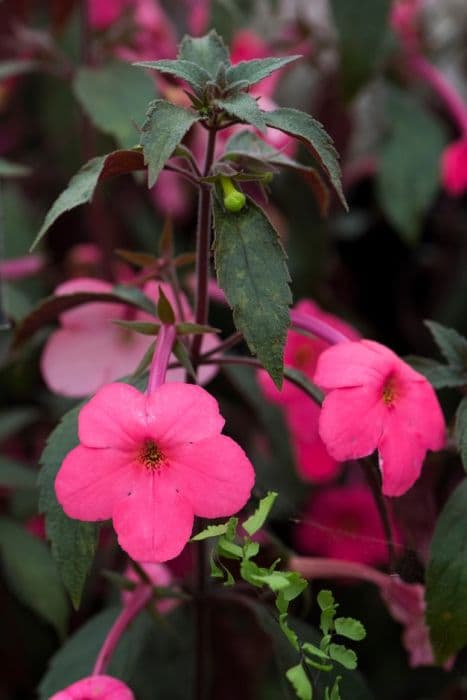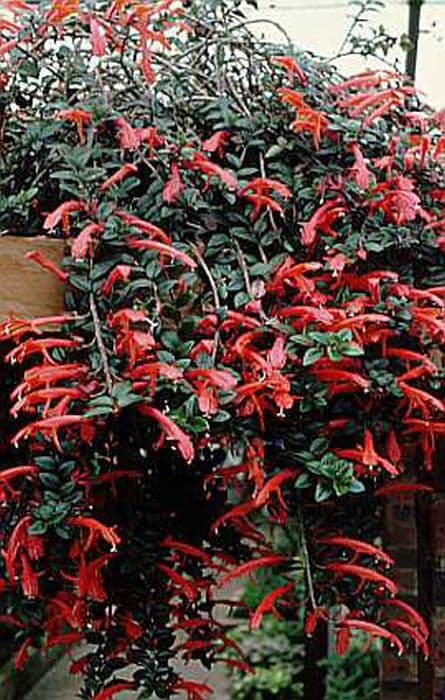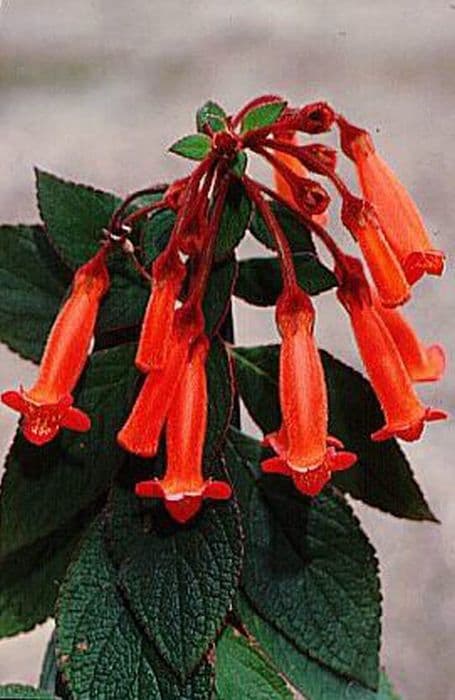Cape Primrose Streptocarpus 'Polka-dot Purple'

ABOUT
The 'Polka-dot Purple' is a striking variety characterized by its vibrant and colorful foliage and blooms. The large, velvety leaves are dark green in hue, providing a lush backdrop for the flowers. These leaves generally have a long, elongated shape with a slight ruffled or wavy texture, contributing to the plant's full and robust appearance. The real showstoppers of this plant are the flowers which feature a distinctive pattern. The blossoms boast a rich purple color, peppered with darker purple to almost black polka dots that create a dramatic contrast. The blooms are trumpet-shaped with a flared mouth, making them quite graceful and eye-catching. These flowers usually grow in clusters at the tips of the stems, adding to the plant's charm and making it a popular choice for indoor displays. The striking purple patterns on the flowers give the plant its descriptive name.
About this plant
 Names
NamesFamily
Gesneriaceae.
Synonyms
Cape Primrose, African Violet.
Common names
Streptocarpus 'Polka-dot Purple'
 Toxicity
ToxicityTo humans
Cape primrose (Streptocarpus 'Polka-dot Purple') is generally considered non-toxic to humans. There are no widely recognized symptoms of poisoning from ingesting this plant, as it is not known to contain any toxic substances that would cause harm to humans if ingested in typical small quantities. However, as with any plant material, individual allergies or sensitivities could potentially cause mild stomach upset or dermatitis in some people.
To pets
Cape primrose (Streptocarpus 'Polka-dot Purple') is not known to be toxic to pets. It is not listed on common toxic plant databases for animals such as dogs and cats. Therefore, if a pet were to ingest parts of this plant, it is unlikely to suffer from any significant symptoms of poisoning. However, ingestion of plant material can sometimes result in gastrointestinal irritation or upset in pets, so it is generally recommended to keep plants out of reach of animals.
 Characteristics
CharacteristicsLife cycle
Perennials
Foliage type
Evergreen
Color of leaves
Green
Flower color
Purple
Height
1 foot (30 cm)
Spread
1 foot (30 cm)
Plant type
Herb
Hardiness zones
10
Native area
Africa
Benefits
 General Benefits
General Benefits- Low Maintenance: Streptocarpus, also known as Cape Primrose, is known for being easy to care for, requiring minimal maintenance.
- Aesthetic Appeal: The 'Polka-dot Purple' variety has vibrant purple flowers with unique patterns that add beauty and color to any space.
- Long Flowering Period: Cape Primrose has a long blooming season which can last from spring to fall with proper care.
- Indoor Adaptability: It thrives well indoors, making it an ideal houseplant for various living conditions.
- Compact Size: Being a relatively small plant, it is suitable for windowsills and tight spaces where larger plants won't fit.
- Emotional Wellbeing: Like many houseplants, the presence of Streptocarpus can contribute to a sense of wellbeing and happiness in the home.
 Medical Properties
Medical PropertiesThis plant is not used for medical purposes.
 Air-purifying Qualities
Air-purifying QualitiesThis plant is not specifically known for air purifying qualities.
 Other Uses
Other Uses- Edible garnish: The vibrant flowers of Streptocarpus can be used as an edible decoration for cakes and pastries, bringing an unexpected splash of color and a mild flavor to desserts.
- Photography subject: Streptocarpus, with its unique patterns and colors, can be an excellent subject for botanical photographers and hobbyists looking to capture the beauty of nature.
- Art inspiration: The intricate patterns of Streptocarpus flowers can inspire artists and designers, translating the natural designs into textiles, wallpapers, or even jewelry.
- Natural dye: The pigments in Streptocarpus flowers can be used to create natural dyes for fabric, offering a range of purples and blues depending on the mordant used.
- Hobbyist breeding: Enthusiasts can crossbreed different varieties of Streptocarpus to create new, unique hybrids with varying patterns and colors for cultivation and display.
- Educational tool: Streptocarpus can serve as an educational specimen for botany students to study the variations and complexities of flowering plant structures and pollination mechanisms.
- Craft projects: Dried flowers of Streptocarpus can be used in crafts, such as in making bookmarks, pressed flower art, or in potpourri mixes.
- Sensory gardens: Streptocarpus can be included in sensory gardens for the visually impaired, offering a soft texture and gentle, non-overpowering scent to the sensory experience.
- Living gifts: As a symbol of friendship and lasting bond, a potted Streptocarpus can be an ideal living gift that grows and flourishes over time.
- Theme gardens: Streptocarpus can be used in purple-themed gardens, where gardeners design their landscape based on color themes, creating a visually captivating garden space.
Interesting Facts
 Feng Shui
Feng ShuiThe Cape Primrose is not used in Feng Shui practice.
 Zodiac Sign Compitability
Zodiac Sign CompitabilityThe Cape Primrose is not used in astrology practice.
 Plant Symbolism
Plant Symbolism- Endurance and Resilience: Streptocarpus, also known as Cape Primrose, often symbolizes endurance due to its ability to thrive in challenging conditions and bloom with minimal care.
- Long-lasting Affection: With its long flowering period, Cape Primrose is associated with lasting affection and enduring relationships.
- Hope and Renewal: The continuous bloom cycle of Cape Primrose can signify hope and the renewal of life, reflecting optimism and the continuous pursuit of happiness.
- Adaptability: As Cape Primrose can adapt to various lighting conditions, it is often associated with the ability to thrive in diverse situations and the importance of being flexible.
 Water
WaterCape primrose, or Streptocarpus 'Polka-dot Purple', prefers consistent moisture but does not do well with waterlogged soil. It should be watered once the top inch of soil feels dry to the touch, which typically means watering about once a week. However, this frequency can change depending on the temperature and humidity of your environment; more water may be needed in warmer, drier conditions. When watering, use room temperature water and thoroughly soak the soil until water runs out of the drainage holes. It is important to avoid getting water on the leaves to prevent fungal diseases. On average, this might mean using about 8-16 ounces of water per week for a small-sized pot, adjusting as needed for the plant's size and environmental conditions.
 Light
LightCape primrose thrives in bright, indirect light; direct sunlight should be avoided as it can scorch the delicate leaves. A north-facing or east-facing window usually provides the ideal light conditions. If you only have a south or west-facing window, use a sheer curtain to diffuse the light and protect the plant.
 Temperature
TemperatureCape primrose fares best in temperatures ranging from 60 to 75 degrees Fahrenheit, making most indoor environments suitable. It can tolerate a minimum temperature of about 50 degrees Fahrenheit but will suffer in temperatures below this. Extreme heat above 80 degrees Fahrenheit can also stress the plant, so it's essential to maintain moderate temperatures for optimal growth.
 Pruning
PruningPruning Cape primrose encourages bushier growth and more blooms. Remove yellowing or dead leaves as needed and pinch back the stem tips after a flowering cycle to promote branching. The best time to prune is just after a flush of blooms has finished. Pruning can be done every few months or as needed to keep the plant looking tidy and to encourage further flowering.
 Cleaning
CleaningAs needed
 Soil
SoilThe African Violet requires a well-draining soil mix, typically a blend of peat moss, perlite, and vermiculite in equal parts, which promotes aeration and moisture retention. The ideal soil pH for African Violets, including Streptocarpus 'Polka-dot Purple', should be slightly acidic, around pH 6.0 to 6.5.
 Repotting
RepottingThe African Violet, including Streptocarpus 'Polka-dot Purple', should be repotted approximately once a year or when it has outgrown its current pot. Repotting in fresh soil helps refresh nutrients and maintain plant health.
 Humidity & Misting
Humidity & MistingAfrican Violets, like Streptocarpus 'Polka-dot Purple', thrive in higher humidity levels, around 50-60%, but can tolerate a range from 40-70%. Avoid overly wet conditions to prevent leaf and root rot.
 Suitable locations
Suitable locationsIndoor
Place African Violet in bright, indirect light, away.
Outdoor
Shelter African Violet from direct sun, keep moist.
Hardiness zone
11-12 USDA
 Life cycle
Life cycleThe Cape primrose, including the 'Polka-dot Purple' variety, begins its life cycle when seeds are sown and germinate, usually in warm and humid conditions. Seedlings emerge, developing their first pair of true leaves following the cotyledons (seed leaves), entering the vegetative stage where they focus on leaf and root growth. As the plant matures, it develops a rosette of leaves and can be propagated from leaf cuttings, which root and form a new plant. Cape primrose will then enter the flowering stage when daylight and temperature conditions are ideal, producing clusters of trumpet-shaped flowers, often in shades of purple with polka-dot patterns for this variety. After pollination, the flowers eventually wilt and the plant sets seed within a characteristic twisted fruit capsule, which can be harvested for propagation purposes. Finally, as a perennial, it enters a period of dormancy, typically in response to cooler or drier conditions, and will resume growth with the return of favorable conditions.
 Propogation
PropogationPropogation time
Spring-Summer
The most popular method for propagating the Streptocarpus 'Polka-dot Purple', commonly known as Cape Primrose, is through leaf cuttings. This should be done in spring or summer when the plant is actively growing. Take a healthy leaf and cut it into sections horizontally or at an angle, each piece should have a vein. Plant the cut ends into a moist, well-draining potting mix, pressing down slightly to ensure contact with the soil. It's crucial the soil stays damp but not waterlogged, and placing the pot in a warm, indirect light area will encourage rooting. Roots and new plants will typically develop at the base of the cuttings in several weeks to a couple of months. Once the new plants have established their own root systems, they can be potted up individually.









